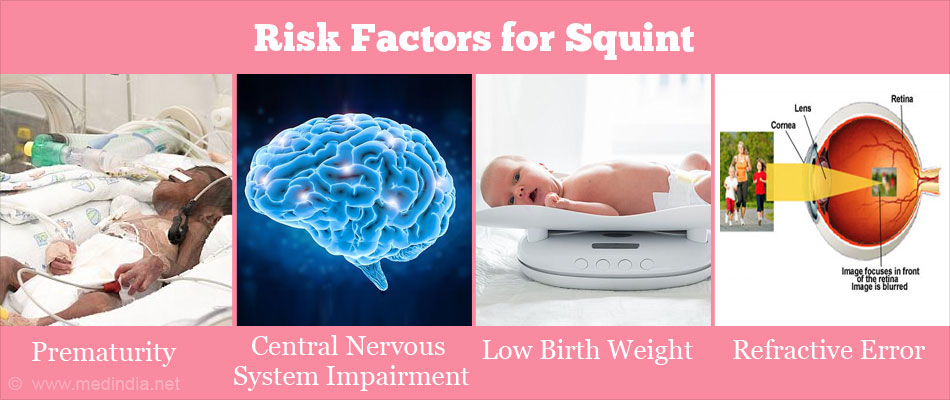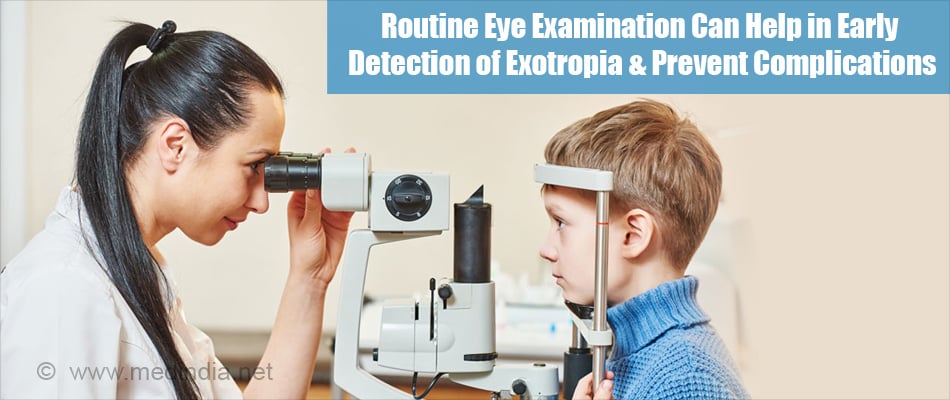- Intermittent exotropia: Surgical treatment strategies - (https://www.ncbi.nlm.nih.gov/pmc/articles/pmc4652245/)
- Cycloplegic Refraction in Children with Cyclopentolate versus Atropine - (https://www.omicsonline.org/cycloplegic-refraction-in-children-with-cyclopentolate-versus-atropine-2155-9570.1000239.php?aid=8171)
- What is exotropia? - (http://www.strabismus.org/exotropia_eye_turns_out.html)
- The use of binocular visual acuity in the assessment of intermittent exotropia - (https://www.ncbi.nlm.nih.gov/pubmed/10849391)
- Know About Exotropia - (http://www.umkelloggeye.org/conditions-treatments/exotropia)
- Diagnostic occlusion test in intermittent exotropia - (https://www.ncbi.nlm.nih.gov/pubmed/18929306)
- Sensory exotropia subsequent to senile cataract - (https://www.ncbi.nlm.nih.gov/pmc/articles/pmc1390648/)
- Information About Exotropia - (http://eyewiki.aao.org/exotropia)
What is Exotropia?
Exotropia is a common form of strabismus or squint (a failure of the two eyes to maintain proper alignment). It is an outward deviation of the eyes that may occur while fixating distance or near objects or both. Exotropia can occur at any age but it is more common in early childhood between 1-4 years of age. Exotropia is more common in Asia, in contrast to convergent squint or inward deviation of the eyes (esotropia) which is more common in the west.
Basics of Squint and Binocular Vision
Strabismus or squint refers to ocular misalignment. Proper ocular alignment is necessary for
- Proper visual stimulation
- Prevention of amblyopia (lazy eye)
- Binocular single vision (the ability to perceive objects seen by both the eyes as one, along with depth perception)
- Cosmesis
Visual stimulation is very crucial in children for proper functional development of the visual system. Any barrier to an appropriate visual stimulus (either in the form of an obstruction such as cataract or an ocular deviation such as squint) can result in the formation of a lazy eye (amblyopia), in which stimulation does not result in a good image, and hence renders vision in that eye subnormal. The younger the child, the greater the chances of and the depth of amblyopia. Binocular vision has 3 grades -
- Simultaneous macular perception (the images of objects in both eyes are appreciated by the patient)
- Fusion (Separate and slightly dissimilar images arising in each eye are appreciated as a single image)
- Stereopsis (Depth perception) This is the highest grade of binocular vision, and which provides us with exceptional skill for certain tasks.
When there is a squint, one or more of these are affected to varying degrees depending on the degree, duration of squint, age at which squint develops and depending on whether it is an intermittent squint or a constant squint.
What are the Different Types of Exotropia?
Exotropia may be broadly classified into two classes: Comitant and Incomitant
| Comitant or incomitant | Type | Features |
| Comitant (degree of deviation constant in all directions of gaze) | Infantile | Manifests within the first year of life Often associated with ocular disorders (such as ptosis, albinism, retinoblastoma, cataracts and 3rd cranial nerve paralysis), and systemic disorders (such as prematurity, cerebral palsy, seizure disorder and hydrocephalus). Treatment is by surgical correction. |
| Intermittent exotropia | Most common form of exotropia. Discussed in detail below. | |
| Sensory exotropia | Occurs as a result of poor vision in one eye, and can occur at any age. The causes for sensory exotropia can be varied – ptosis (drooping of eyelid to obstruct vision, cloudiness of the cornea, cataract, tumors like retinoblastoma, optic nerve defects, refractive errors. | |
| Consecutive exotropia | Occurs after surgery for a convergent squint (esotropia). | |
| Incomitant (deviation varies in different directions of gaze) | Paralytic exotropia | Central nervous system disorders such as tumors, Third nerve paralysis, Disorders of the muscles moving the eyes such as thyroid eye disease, myasthenia gravis. |
| Restriction of movement of the eyes resulting in ocular misalignment | Tumors in the orbit, Fibrosis of muscles moving the eyes, Duane’s syndrome |
The treatment of incomitant deviations consists of treatment of the primary condition.
Intermittent Exotropia -
This is the most common form of exotropia and accounts for about 50–90% of all the exotropia and affects about 1% of the general population.The onset of intermittent exotropia is usually between 12 months and 4 years of age. In children, exotropia may be preceded by exophoria (latent divergent squint), and the eye turn might only be visible during stressful situations such as fatigue, illness or stress. Closure of one eye in bright sunlight is another feature of intermittent exotropia. In adults, it can manifest as a result of consuming alcohol or sedatives.
Initially the exotropia manifests on only while viewing distant objects; later the exotropia for near also increases. Intermittent exotropia may remain stable, or may evolve to constant exotropia. Constant exotropia can lead to variable degrees of diminished binocular function and lazy eye.
| Major Risk Factors for Squint |
|

How is Exotropia Classified?
- If the outward deviation is more for distance fixation than for near , it is called the divergence excess type of exotropia.
- If the deviation is more for near than for distance vision, it is referred to as the convergence insufficiency type of exotropia.
- If little or no difference is noted between near and distance deviation, it is called the basic type of exotropia.
What are the Signs and Symptoms of Exotropia?
Mostly the first signs of exotropia appear during childhood. The common symptoms include:
- Decreased vision, either due to refractive error, disorder in the eye,or due to suppression
- Outward deviation of the eyes
- Reduced binocular function
- Photosensitivity or increased sensitivity to bright light
- Double vision if the exotropia is intermittent.

Consequences of Untreated Exotropia
- Suppression of image in the deviating eye to prevent double vision and confusion. Thus the higher degrees of binocular vision are affected.
- Abnormal retinal correspondence
- A poor adaptation made by the sensory mechanisms to maintain some sort of binocular vision even in the presence of a squint.
- This should be specifically looked for in every patient of squint prior to surgical correction. If present, this should be addressed, otherwise surgical correction of the squint can lead to double vision.
How do You Diagnose Exotropia?
The outward deviation is obvious and patient presents mainly with this symptom. Do not confuse exotropia with the transient outward wandering of the eyes that occurs in about 60-70% of normal newborns, and which resolves by 6 months of age.
How do You Evaluate a Person With Exotropia?
Visual acuity measurement- Visual acuity might be normal or abnormal. Diminished vision may either be due to a refractive error, pathology such as cataract or retinal disorders, suppression , or a combination of these factors. Visual acuity measurement in younger children is more challenging. There are special charts and devices for this purpose and require a great deal of patience.
Cycloplegic refraction: It is an objective determination of the true refractive error, by elimination of the effect of accommodation. This is achieved by paralyzing the ciliary muscle with cyclopentolate eye drops or atropine eye ointment. These drugs also cause dilatation of the pupil making it easier for the doctor to examine the retina.
- Slit lamp exam- This test checks for any diseases or abnormalities in the anterior portion of the eye.
- Fundus (retina) examination- It is also referred to as fundoscopy, and is used to view the eye's interior portion, involving assessment of the retina, optic nerve, blood vessels, and other features:
- Measurement of the amount of deviation
- Assessment of movement of the eyes in various directions of gaze
- Check for double vision, and if present, determine the type
- Determine the degree of binocular vision that is present –
- Check for ability of fusion of the images of the 2 eyes
- Check for depth perception
- Check for suppression
- Check for abnormal retinal correspondence
How do You Treat Exotropia?
Exotropia can be managed both by non-surgical and surgical treatments depending upon the condition of patient.
Non-surgical methods
- Correction of refractive error- Refractive errors like myopia, astigmatism, and high degrees of hypermetropia need to be corrected both for improvement of vision as well as to help in reducing the stimulus for exotropia. Some eye doctors prescribe additional minus lenses to stimulate accommodation (which is always accompanied by convergence ) to help in controlling the outward deviation. This may be useful in delaying surgery in some people.
- Orthoptic treatment makes use of fusional training exercises. Small intermittent deviations respond better than large and constant deviations.
- Occlusion technique: This technique is beneficial for use in very young children.
Patching the dominant eye or alternate patching of either eye is performed to interrupt and reduce the progression of the exotropia. Continued part-time patching (2-4 hours per day) helps the brain stop using abnormal neurological pathways while encouraging the normal neurological pathway. This technique is not usually effective for long, and in some patients can result in progression of the exotropia.
Prism therapy- Base-in-prisms (prisms incorporated into spectacles with the base of the prism towards the nose) are extremely helpful in improving the appearance of the eyes and facilitating the patient’s communication and interaction with others. It alleviates difficulties associated with misalignment. It is useful for older patients with limited fusional capabilities.
Surgical correction:
Surgery is generally considered only after unsatisfactory non-surgical approaches. The goals of surgery are restoration of alignment and binocular function.
How do You Prevent Exotropia?
Following points may help to prevent or worsen Exotropia:
- Routine eye check-ups to detect latent squint, refractive errors and application of corrective measures.

- Avoiding stressful conditions as much as possible.








